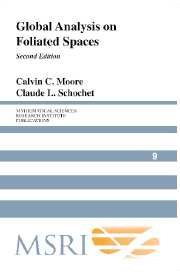Book contents
- Frontmatter
- Contents
- Preface to the Second Edition
- Preface to the First Edition
- Introduction
- Chapter I Locally Traceable Operators
- Chapter II Foliated Spaces
- Chapter III Tangential Cohomology
- Chapter IV Transverse Measures
- Chapter V Characteristic Classes
- Chapter VI Operator Algebras
- Chapter VII Pseudodifferential Operators
- Chapter VIII The Index Theorem
- Appendix A The ∂̄-Operator
- Appendix B L2 Harmonic Forms on Noncompact Manifolds
- Appendix C Positive Scalar Curvature Along the Leaves
- Appendix D Gap Labeling
- References
- Notation
- Index
Introduction
Published online by Cambridge University Press: 06 July 2010
- Frontmatter
- Contents
- Preface to the Second Edition
- Preface to the First Edition
- Introduction
- Chapter I Locally Traceable Operators
- Chapter II Foliated Spaces
- Chapter III Tangential Cohomology
- Chapter IV Transverse Measures
- Chapter V Characteristic Classes
- Chapter VI Operator Algebras
- Chapter VII Pseudodifferential Operators
- Chapter VIII The Index Theorem
- Appendix A The ∂̄-Operator
- Appendix B L2 Harmonic Forms on Noncompact Manifolds
- Appendix C Positive Scalar Curvature Along the Leaves
- Appendix D Gap Labeling
- References
- Notation
- Index
Summary
Global analysis has as its primary focus the interplay between the local analysis and the global geometry and topology of a manifold. This is seen classically in the Gauss–Bonnet theorem and its generalizations, which culminate in the Atiyah–Singer Index Theorem [Atiyah and Singer 1968a]. This places constraints on the solutions of elliptic systems of partial differential equations in terms of the Fredholm index of the associated elliptic operator and characteristic differential forms which are related to global topological properties of the manifold.
The Atiyah–Singer Index Theorem has been generalized in several directions, notably by Atiyah and Singer themselves [1971] to an index theorem for families. The typical setting here is given by a family of elliptic operators P = {Pb} on the total space of a fibre bundle F → M → B, where Pb is defined on the Hilbert space L2(p−1(b), dvol(F)). In this case there is an abstract index class ind(P) ∈ K0(B). Once the problem is properly formulated it turns out that no further deep analytic information is needed in order to identify the class. These theorems and their equivariant counterparts have been enormously useful in topology, geometry, physics, and in representation theory.
A smooth manifold Mn with an integrable p-dimensional subbundle F of its tangent bundle TM may be partitioned into p-dimensional manifolds called leaves such that the restriction of F to the leaf is just the tangent bundle of the leaf.
- Type
- Chapter
- Information
- Global Analysis on Foliated Spaces , pp. 1 - 12Publisher: Cambridge University PressPrint publication year: 2005

